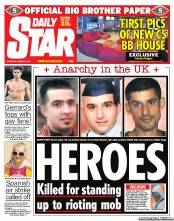Three Asians Dead In Birmingham: Blacks And Poor Whites Are Hate Figures In ‘Looming Race War’
 HAROON Jahan, 21,Shazad Ali, 30, his brother, Abdul Musavir, 31, are dead. They were on the street protecting their area of Birmingham when they were killed by car. The three men are of Pakistani origin. The two men in the car were black. A man has been arrested on suspiscion of murder.
HAROON Jahan, 21,Shazad Ali, 30, his brother, Abdul Musavir, 31, are dead. They were on the street protecting their area of Birmingham when they were killed by car. The three men are of Pakistani origin. The two men in the car were black. A man has been arrested on suspiscion of murder.
The papers are quick to praise them.
The Daily Star calls them “HEROES” on its front page. The Mirror agrees. They are once more front-page “heroes“.
The tabloids love to protect a story in monochrome black and white. And black is bad. Working class white is worse – they are the one group it is still alright to call names and insult. Colour matters. The Times talks of a “looming race war“:
Tension crackled like static on the dusty streets of Winson Green yesterday. In a city whose Asian and African-Caribbean communities have not always enjoyed harmonious relations, young British Pakistanis gathered in huddles predicting a looming race war… Lost on no one was the ethnicity of the men in two cars which at 1.10am on Wednesday were driven at speed directly into a group standing on the pavement outside a petrol station.
That sounds a lot like murder? But we do not know. We must not rush to judge. But others are more rash:
“Three days ago they were vandals, two days ago they were looters. And now they’ve become murderers,” said a man among the crowd of 150 who later congregated outside a hall where a community meeting was in progress. One of theirs died in London and look what’s happened. Now three of ours have been killed. The rules of the game changed last night.”
 The impression is of the hard working Asian and the feckless black man. Are three men killed by a speeding car heroes? Are are the tabloid press more eager to side with one race then an other? In Eltham (tropic of Millwall), the Telegraph sees white racism at work:
The impression is of the hard working Asian and the feckless black man. Are three men killed by a speeding car heroes? Are are the tabloid press more eager to side with one race then an other? In Eltham (tropic of Millwall), the Telegraph sees white racism at work:
Riot police were hit with missiles including bottles as more than 1,000 officers battled with dozens of middle-aged men on the streets Eltham, south-east London. Witnesses reported that many of the 200 men were chanting in support of the English Defence League, the controversial Right-wing group. The group had promised to defy police orders and mobilise their own forces to protect their families and businesses from mobs of looters.
With shops and pubs in the high street shut, the group brought carrier bags containing beer and drank and sat on benches. Riot police eventually restored order after charging at the crowd. At least one person was arrested. Around 60 EDL supporters had gathered in the square in the town drinking cans of beer and chanting “We love you England”.
The media searches for things that have changed; got worse – but they stay the same. As our Ed Barrett wrote of South London:
This negative image was periodically confirmed on the rare occasions that the area hit the headlines: Teds and cosh boys in the fifties; the Richardson gang and the dockers’ march for Enoch in the sixties; the Lewisham riot and the Panorama programme on Millwall hooligans in the seventies; and so on. Even a good-news story like the Millennium Dome ended up as a PR disaster.
Then, in 1993, South-East London’s outlaw image was crystallised in the biggest bad-news story of all: the murder of Stephen Lawrence. After the collapse of the prosecution, and the ensuing public debate, the case took on a symbolic significance. Lawrence was by no means the first young black man to be murdered in the borough of Greenwich, but his respectability made him a media-friendly victim. The racist suspects, meanwhile, were perfect public enemies from the traditionally white working-class enclave of Eltham…
Even liberals who would once have patronised working people as victims of the system now regarded them as out of step with modern metropolitan values. They were vulgar, ignorant, rude, violent, and, worst of all, an obstacle to the creation of a multicultural society.
The three men in Winson Green, Birmingham lived in an area that is 35 per cent Asian, 24 per cent African-Caribbean and 34 per cent white. The country is split into places where like lives with like. But if you want one thing that binds these groups it is that they are working class – they have neither political power nor cultural cachet.
Posted: 11th, August 2011 | In: Key Posts, Reviews Comments (17) | TrackBack | Permalink


